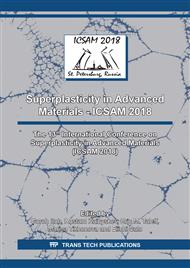[1]
R.Z. Valiev, R.K. Islamgaliev, I.V. Alexandrov, Bulk nanostructured materials from severe plastic deformation, Progress in Materials Science. 45 (2000) 103-189.
DOI: 10.1016/s0079-6425(99)00007-9
Google Scholar
[2]
I. Sabirov, Enhanced ductility of ultra-fine grained metallic materials, Letters on materials. 5 (2015) 347-353.
DOI: 10.22226/2410-3535-2015-3-347-353
Google Scholar
[3]
Z. Liu, M.A. Meyers, Z. Zhang, R. Ritchie, Functional gradients and heterogeneities in biological materials: Design principles, functions, and bioinspired applications, Progress in Materials Science. 88 (2017) 467-498.
DOI: 10.1016/j.pmatsci.2017.04.013
Google Scholar
[4]
Z. Liu, Y. Zhu, D. Jiao, Z. Weng, Z. Zhang, R. Ritchie, Enhanced protective role in materials with gradient structural orientations: Lessons from Nature, Acta Biomaterialia. 44 (2016) 31-40.
DOI: 10.1016/j.actbio.2016.08.005
Google Scholar
[5]
R. Ritchie, The conflicts between strength and toughness, Nature Materials. 10 (2011) 817-822.
Google Scholar
[6]
X. Yang, X. Wang, X. Ling, D. Wang, Enhanced mechanical behaviors of gradient nano-grained austenite stainless steel by means of ultrasonic impact treatment, Results in Physics. 7 (2017) 1412-1421.
DOI: 10.1016/j.rinp.2017.04.002
Google Scholar
[7]
Y. Huang, L. Wan, S. Lv, H. Liu, J. Feng, Gradient micro-structured surface layer on aluminum alloy fabricated by in situ rolling friction stir welding, Materials and Design. 52 (2013) 821-827.
DOI: 10.1016/j.matdes.2013.06.026
Google Scholar
[8]
W. Chen, Z.S. You, N.R. Tao, Z.H. Jin, L. Lu, Mechanically-induced grain coarsening in gradient nano-grained copper, Acta Materialia. 125 (2017) 255-264.
DOI: 10.1016/j.actamat.2016.12.006
Google Scholar
[9]
W.L. Li, N.R. Tao, K. Lu, Fabrication of a gradient nano-micro-structured surface layer on bulk copper by means of a surface mechanical grinding treatment, Scripta Materialia. 59 (2008) 546-549.
DOI: 10.1016/j.scriptamat.2008.05.003
Google Scholar
[10]
K. Lu, Making strong nanomaterials ductile with gradients, Science. 345 (2014) 1455-1456.
DOI: 10.1126/science.1255940
Google Scholar
[11]
T.H. Fang, W.L. Li, N.R. Tao, K. Lu, Revealing extraordinary intrinsic tensile plasticity in gradient nano-grained copper, Science. 331 (2011) 1587-1590.
DOI: 10.1126/science.1200177
Google Scholar
[12]
J. Li, S. Chen, X. Wu, A.K. Soh, A physical model revealing strong strain hardening in nano-grained metals induced by grain size gradient structure, Materials Science and Engineering: A. 620 (2015) 16-21.
DOI: 10.1016/j.msea.2014.09.117
Google Scholar
[13]
W. Zhang, W.T. Huo, J.W. Lu, J.J. Hu, Q. Wei, Y.S. Zhang, Gradient shear banding in a magnesium alloy induced by sliding friction treatment, Vacuum. 143 (2017) 95-97.
DOI: 10.1016/j.vacuum.2017.05.035
Google Scholar
[14]
K. Lu, J. Lu, Nanostructured surface layer on metallic materials induced by surface mechanical attrition treatment, Materials Science and Engineering: A. 375-377 (2004) 38-45.
DOI: 10.1016/j.msea.2003.10.261
Google Scholar
[15]
M. Liu, J.Y. Li, Y. Ma, T.Y. Yuan, Q.S. Mei, Surface nanocrystallization and property of Ti6Al4V alloy induced by high pressure surface rolling, Surf. Coatings Technol. 289 (2016) 94-100.
DOI: 10.1016/j.surfcoat.2016.01.043
Google Scholar
[16]
Y. Li, K. Sun, P. Liu, Y. Liu, P. Chui, Surface nanocrystallization induced by fast multiple rotation rolling on Ti-6Al-4V and its effect on microstructure and properties, Vacuum. 101 (2014) 102-106.
DOI: 10.1016/j.vacuum.2013.07.028
Google Scholar
[17]
H. Yu, C. Lu, A. Tieu, H. Li, A. Godbole, S. Zhang, Special rolling techniques for improvement of mechanical properties of ultrafine-grained metal sheets: a review, Advanced Engineering Materials. 18 (2015) 754-769.
DOI: 10.1002/adem.201500369
Google Scholar
[18]
Y.H. Ji, J.J. Park, Development of severe plastic deformation by various asymmetric rolling processes, Materials Science and Engineering: A. 499 (2009) 14-17.
DOI: 10.1016/j.msea.2007.11.099
Google Scholar
[19]
B. Ma, C. Li, J. Wang, B. Cai, F. Sui, Influence of asymmetric hot rolling on through-thickness microstructure gradient of Fe-20Mn-4Al-0.3C non-magnetic steel, Materials Science and Engineering: A. 671 (2016) 190-197.
DOI: 10.1016/j.msea.2016.06.047
Google Scholar
[20]
J.J. Park, Finite-element analysis of severe plastic deformation in differential-speed rolling, Computational Materials Science. 100 (2015) 61-66.
DOI: 10.1016/j.commatsci.2014.09.010
Google Scholar
[21]
A. Pesin, D. Pustovoytov, Influence of process parameters on distribution of shear strain through sheet thickness in asymmetric rolling, Key Engineering Materials. 622-623 (2014) 929-935.
DOI: 10.4028/www.scientific.net/kem.622-623.929
Google Scholar
[22]
A. Pesin, D. Pustovoytov, Finite element simulation of extremely high shear strain during a single-pass asymmetric warm rolling of Al-6.2Mg-0.7Mn alloy sheets, Procedia Engineering. 207 (2017) 1463-1468.
DOI: 10.1016/j.proeng.2017.10.914
Google Scholar


